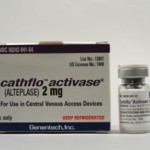 I cannot find much information about how Alteplase (Activase, synthetic tissue plasminogen activator, TPA) therapy affects fibrinogen assays. Are there any guidelines or references for specimen acceptability (time from collection) for coagulation testing when Alteplase is in use? Thanks.
I cannot find much information about how Alteplase (Activase, synthetic tissue plasminogen activator, TPA) therapy affects fibrinogen assays. Are there any guidelines or references for specimen acceptability (time from collection) for coagulation testing when Alteplase is in use? Thanks.
Carla Purvis MT (ASCP)SH
Parkview Health System, Fort Wayne, IN
Hi, Carla, and thanks for your question. I found no published guidelines that provide timing for fibrinogen assays after Alteplase therapy, however I’ve attached the Alteplase package insert, which provides its clinical pharmacology: Activase Package Insert.
You’ll see from the package insert that Alteplase clears from plasma with a half-life of five minutes, implying that you should be able to get a valid measure of fibrinogen less than an hour after completion of therapy.
However, your question made me recall an article, Molk B. Acute myocardial infarction in an unsuspecting male. Clinical Hemostasis Review, February, 1997, Page 14. The patient was president of a coagulation reference laboratory, and when he recognized his AMI symptoms, he had the presence of mind to ask one of the lab’s professional staff to accompany him and collect timed specimens. The results are in table 1, and as you can see, 24 hours after his TPA infusion, his fibrinogen had not returned to admission concentration. Based on this, I conclude you need to wait at least 24 hours after Alteplase therapy to resume fibrinogen measurements. Click below to see the case study. Geo.


Shortly after Gordon’s response, I received this from Flo:
Shortly after Gordon’s response, I received this from Flo:
“Dear friends,
The true story of my role and our ‘Unsuspecting Male‘ is as follows: I had just arrived for work and got a call from the ER nurse…Gordon Ens has asked that you come to ER at Rose Hospital because he has had a heart attack! I literally ran out of the building and ran the one block to Rose. When I arrived, Gordon was lying on the gurney with a blue top tube of blood on his tummy. The doctor is asking him how bad his pain is on a scale of 0-10; “8,” he says and then turns to me and says calmly, ‘Test this tube of blood for all the appropriate tests and can you come and pick up a sample from every draw hereafter?’ They then wheel him off to surgery and I am still in a state of shock!
That day and every day until he was released, I went over 3-4 times a day to get a fresh tube of blood at the lab where I made arrangement for them to call me ASAP after each draw.
The resulting clinical study is probably one of the most accurate time progression studies of coagulation testing of an MI ever done in 1996. Wish we’d had all the new tests that are available today.
After my dear partner and friend recovered fully, I gave him a hug but still have not forgiven him for driving himself to the hospital while having angina!! Only those that don’t know better do that, I told him and we still laugh about the whole incident because that “little angel” on his shoulder was and still is blessing him daily.
It is no surprise to me that “Unsuspecting Male” Gor
It is no surprise to me that “Unsuspecting Male” Gordon Ens saw Carla’s post and decided to add his history:
“I remember it as if it were yesterday! March 20, 1996. Interesting to read about it in such a clinical fashion. I note that Barry Molk, MD (my cardiologist) and I were quite accurate in our details with just a couple of small ‘facts’ slightly twisted, probably to add to the drama. George did a good job in recreating the setting but I feel obligated to note several significant points. The patient did not just request any technologist to come to his aid, he called for the best, Florence Newlin. He would not have trusted his specimens to anyone of lesser stature. Secondly, he was actually laying on his back on a gurney with morphine dripping into his veins and he still had the presence to call Flo and not let them start the TPA until she had collected the specimens, much to the chagrin of the attending medical staff. The ability to make quick, rational decisions while in a morphinized state speaks to my years of experience reacting under duress and pressure. The anesthesiologist was just asking me on a scale of 0 to 10 what my pain level was when Flo ran into the room.”